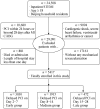Patients with ST-segment elevation of myocardial infarction miss out on early reperfusion: when to undergo delayed revascularization
- PMID: 29089969
- PMCID: PMC5653899
- DOI: 10.11909/j.issn.1671-5411.2017.08.006
Patients with ST-segment elevation of myocardial infarction miss out on early reperfusion: when to undergo delayed revascularization
Abstract
Objective: There are still a high proportion of patients with ST-segment elevation myocardial infarction (STEMI) missing out early reperfusion even in the primary percutaneous coronary intervention (PCI) era. Most of them are stable latecomers, but the optimal time to undergo delayed PCI for stable ones remains controversial.
Methods: We investigated all STEMI patients who underwent delayed PCI (2-28 days after STEMI) during 2007-2010 in Beijing and excluded patients with hemodynamic instability. The primary outcome was major adverse cardiovascular events (MACEs).
Results: This study finally enrolled 5,417 STEMI patients and assigned them into three groups according to individual delayed time (Early group, 55.9%; Medium group, 35.4%; Late group, 8.7%). During 1-year follow-up, MACEs occurred in 319 patients. The incidence of MACEs were respectively 7.1%, 5.6% and 6.7% among three groups. The Medium group had less recurrent myocardial infarction plus cardiac death (hazard ratio, 0.525; 95% confidence interval, 0.294-0.938, P = 0.030) than Late group and less repeat revascularization (hazard ratio, 0.640; 95% confidence interval, 0.463-0.883, P = 0.007) than Early group in pairwise comparisons. We depicted the incidence of major adverse cardiovascular event (MACE) by delayed time as a quadratic curve and found the bottom appeared at day 14.
Conclusions: The delayed PCI time varied in the real-world practice, but undergoing operations on the second week after STEMI had greater survival benefit and less adverse events for whom without early reperfusion and hemodynamic instability.
Keywords: Angioplasty; Epidemiology; Latecomer; Myocardial infarction; Stents.
Figures



Similar articles
-
Efficacy of high-dose atorvastatin loading before primary percutaneous coronary intervention in ST-segment elevation myocardial infarction: the STATIN STEMI trial.JACC Cardiovasc Interv. 2010 Mar;3(3):332-9. doi: 10.1016/j.jcin.2009.11.021. JACC Cardiovasc Interv. 2010. PMID: 20298994 Clinical Trial.
-
[Long-term outcomes of patients with ST-elevation myocardial infarction undergoing early versus late delayed percutaneous coronary intervention using drug-eluting stents].Zhonghua Xin Xue Guan Bing Za Zhi. 2020 Feb 24;48(2):118-122. doi: 10.3760/cma.j.issn.0253-3758.2020.02.006. Zhonghua Xin Xue Guan Bing Za Zhi. 2020. PMID: 32135611 Chinese.
-
Delayed angioplasty is superior to an emergency strategy in ST-segment elevation myocardial infarction patients who present late and with infarct artery spontaneous reperfusion before intervention.Cardiovasc J Afr. 2019 May/Jun 23;30(3):162-167. doi: 10.5830/CVJA-2019-009. Epub 2019 May 16. Cardiovasc J Afr. 2019. PMID: 31144708
-
Electrocardiogram score for the selection of reperfusion strategy in early latecomers with ST-segment elevation myocardial infarction.J Electrocardiol. 2015 Mar-Apr;48(2):260-7. doi: 10.1016/j.jelectrocard.2015.01.004. Epub 2015 Jan 6. J Electrocardiol. 2015. PMID: 25601410
-
Meta-analysis of randomized controlled trials comparing percutaneous coronary intervention with aspiration thrombectomy Vs. Conventional percutaneous coronary intervention during ST-segment elevation myocardial infarction.Catheter Cardiovasc Interv. 2016 Jun;87(7):1203-10. doi: 10.1002/ccd.26352. Epub 2015 Dec 23. Catheter Cardiovasc Interv. 2016. PMID: 26699698 Review.
Cited by
-
Effect of primary PCI on the recovery of atrioventricular block in inferior STEMI patients with late presentation (>12 hours): insights from a single center 10-year experience.J Investig Med. 2020 Jun;68(5):1011-1014. doi: 10.1136/jim-2019-001255. Epub 2020 Mar 25. J Investig Med. 2020. PMID: 32217628 Free PMC article.
-
Early versus late delayed percutaneous coronary intervention in elderly patients with ST-segment elevation myocardial infarction.Aging Clin Exp Res. 2023 Jun;35(6):1317-1324. doi: 10.1007/s40520-023-02417-8. Epub 2023 May 12. Aging Clin Exp Res. 2023. PMID: 37171538
-
Sphingosine-1-phosphate improves outcome of no-reflow acute myocardial infarction via sphingosine-1-phosphate receptor 1.ESC Heart Fail. 2023 Feb;10(1):334-341. doi: 10.1002/ehf2.14176. Epub 2022 Oct 11. ESC Heart Fail. 2023. PMID: 36217778 Free PMC article.
-
Feasibility and efficacy of delayed pharmacoinvasive therapy for ST-elevation myocardial infarction.World J Cardiol. 2023 Jan 26;15(1):23-32. doi: 10.4330/wjc.v15.i1.23. World J Cardiol. 2023. PMID: 36714366 Free PMC article.
-
In-hospital outcomes of delayed stenting in hemodynamically stable patients with ST-segment elevation myocardial infarction: the CCC (Care for Cardiovascular Disease in China) project.Cardiovasc Diagn Ther. 2019 Oct;9(5):462-471. doi: 10.21037/cdt.2019.08.10. Cardiovasc Diagn Ther. 2019. PMID: 31737517 Free PMC article.
References
-
- Dai X, Kaul P, Smith SC, Jr, et al. Predictors, treatment, and outcomes of STEMI occurring in hospitalized patients. Nat Rev Cardiol. 2016;13:148–154. - PubMed
-
- Nielsen PH, Terkelsen CJ, Nielsen TT, et al. System delay and timing of intervention in acute myocardial infarction (from the Danish Acute Myocardial Infarction-2 [DANAMI-2] trial) Am J Cardiol. 2011;108:776–781. - PubMed
Grants and funding
LinkOut - more resources
Full Text Sources
Miscellaneous
